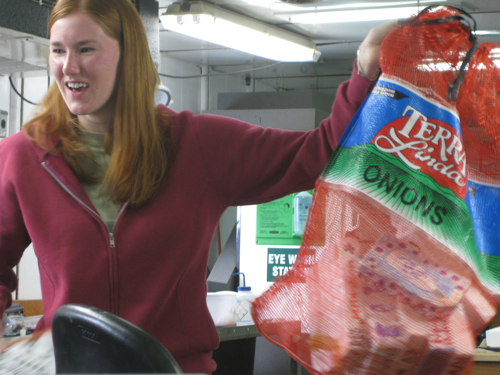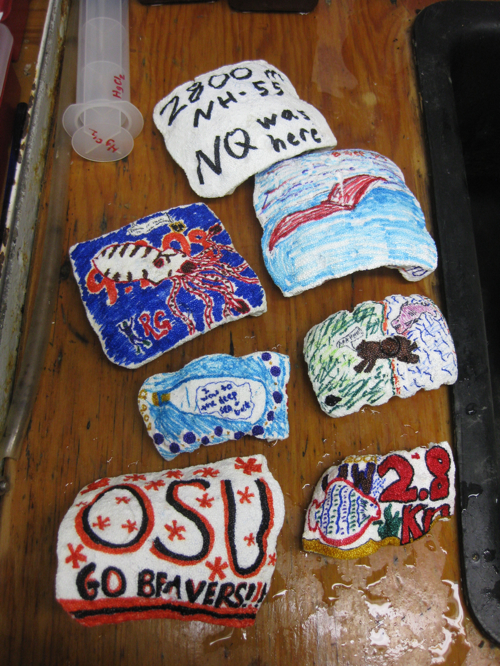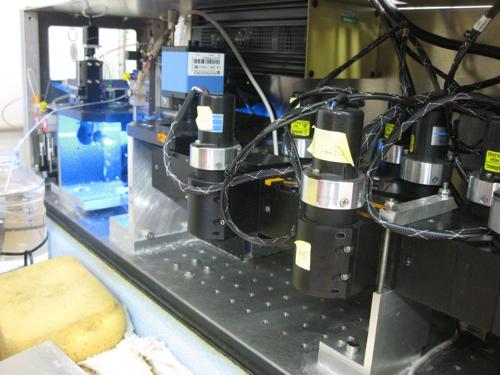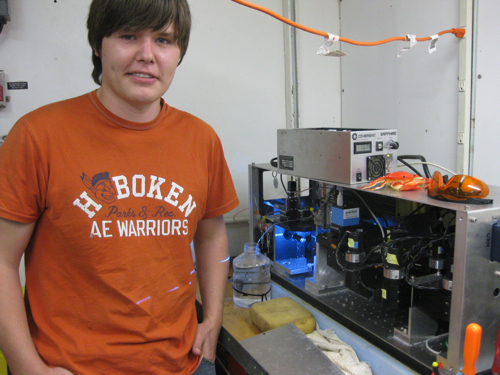You are here
Crushing pressures, sharks, & laser beams (9/9/09)

Morgaine McKibben and Colleen Durkin create marker-masterpieces on foam chunks in preparation for the 2800 meter CTD drop
Today was pretty low-cal, steaming along the Newport Hydroline, making CTD drops at the standard stations. The water was particularly clear, perhaps in some part to the downwelling conditions that have prevailed over the last several days. I think we are starting to feel ready to go home. I thought a lot about my children starting school, and wished I was there to see them off -- particularly my 5 year old who is starting kindergarten (go Milo!). We all needed a diversion. In response to this need, our crack scientific team decided to take advantage of the tremendous pressures present at the bottom of the day's final CTD cast (about 300 times what you and I are used to), by squashing junk. And just to keep things interesting, the junk in question would be decorated. Oh yeah.

Matt Wolhowe, Pete Kahl, Sara Bender, Morgaine, and Colleen add a little flair to their styrofoam shrinky-dinks
The junk most often sacrificed to Poseidon by thrill-seeking oceanographers is styrofoam cups, but we have none on the ship. Instead, a stack of styrofoam tube racks was assembled, decorated with beautiful and significant art, and attached to the CTD carousel in an onion sack. Once all was in order, the CTD was sent to almost 2900 meters...and the styrofoam junk to a profound metamorphosis. I'm actually a little surprised Cap'n Wes let us move styrofoam from the deck of the ship to the water; this whole cruise he has been passionate and tireless in his efforts to get us forgetful scientists to keep our plastic garbage separate from the biodegradable trash that ends up in the ocean...bless his heart.

Vikki prepares to strap the bag of styrofoam to the CTD carousel

The profoundly humbling results of ~45000 pounds per square inch pressure
As you can see from the photo, the tube racks came up deliciously stunted and bent -- and the drawings got tiny too! Everyone was very happy with their souvenirs. Several were snatched up and spirited away before I had the chance to photograph them.

That's right -- we have a freaking laser on board!
I was thinking about what to blog about and realized that there's a freaking laser in the wetlab, and I haven't even taken a photo of it yet! So I took some photos of the science-box the cool laser is mounted inside and talked with Justin Reina about just how cool that laser is. Justin even held a q-tip in the beam and it smoked! Up to that point I had been pretty casual about avoiding looking at the laser. Not anymore, though. In fact, although I am fond of affecting disinterest in science-boxes, they truly are quite cool, and this one is no exception. It's a flow-cytometer, specifically adapted to measure the number and size of phytoplankton particles in the water in real-time. This tool even has the potential to identify the species of phytoplankton by the characteristic way their shapes interfere with the laser beam. If you have been following my blog, you have seen "real-time" come up quite a bit. The traditional methodologies of biological oceanography have been comparatively labor-intensive, limiting the scales over which we can observe biological processes in the ocean, right where they happen. Tools like Justin's flow-cytometer, Natalja's FlowCAM, and Missy's APNA promise to provide us with scads of high-quality data, at a much higher resolution in space and time than has been possible in the past. Good stuff!

The whole package, full of photo-multipliers, wires, and retina-burning rod-cell death

Justin Reina with his sci-box
And in the animal watching department, I have a few things to report. The birds have been relatively disappointing; pretty much nothing but gulls. I feel bad saying that -- gulls are birds too, after all (I blame my indifference to gulls on the producers/writers of Finding Nemo). While talking with Cap'n Wes on the bridge, chief scientist Tawnya Peterson saw a big shark approach and pass the ship. She wasn't sure of the species, but described it as big, broad, and swimming with its dorsal fin clear of the surface. We all decided that it had to have been a great white shark. Tawnya was uncomfortable saying this, but I'm not. Isn't it cool we saw a great white shark? We also saw a pod of Dall's porpoise! They saw us, came over to check us out, decided we were lame, and left. All in that order. In about as much time as it took you to read the sentence. Obviously there are no photos, although Vikki Campbell did get some brief video. Of course Vikki neglected to bring her camera cable, so I am unable to share any images with you...bless her heart as well. I'm quite disappointed to not have photos to share, because Dall's porpoise are soooo lovely -- black, with clean-edged white patches on their sides. They are sort of like cute little ADHD afflicted mini-orca.

Patrick Prahl and his tube-rack, just before the big drop



